So, now the part of the disassembly that caused me the most head scratching - the instrument panel and wiring.
My original thought was to end up with an IFR trainer. I believed then and still do that the Brantly would make a great little IFR trainer. Ah, but how to do it? I originally thought I would use a Dynon D-10A as an HSI, especially now that Dynon has their neat, new HS34 HSI expansion module. The HS34 would allow me to use nav inputs from an SL30 as well as my Garmin 496 which would easily cover the bases for the IFR requirements as well as allowing for a little more modern equipment added to the mix. Ah, but then I heard about Aspen avionics new EFIS. It seemed like just the ticket; 2.2 lbs, slide in replacement for both the artificial horizon and HSI/DG. Alas after talking with the Aspen rep at the local aviation expo he told me they had determined it would not work in a helicopter at this point. They are working with Robinson to correct that but it will be some time yet. Well, that points me back to the Dynon...
So what does this have to do with the instrument panel and wiring I hear you ask?
1. I had bought a new panel from Brantly to allow me the extra clearance from the six pack to the upper three 2 1/8 holes for mounting the Aspen EFIS. Out with the old, in with the new and at less than $200 another reason to love the Brantly!
2. I needed to know what extra wiring to lay into the harness for future modification to make this an instrument trainer as at this time the budget does not allow me to install all the goodies I would like to at this time.
My final determination is that I will provide for the installation of an SL30 radio, Dynon D10A with HS34 expansion module, GTX327 transponder and either a 12 volt attitude indicator or a second Dynon D10A. I will be installing the wiring in anticipation of installing this equipment in the future so that all that will be required is to simply do the mounting of the equipment and plug it in.















